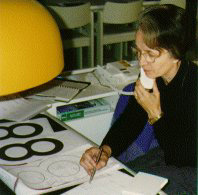LEA NUMBERS® TESTS
LEA NUMBERS® were developed for international studies in occupational health and school health services. Letters like the Sloan letters are used in the Western world and in the old colonies of western empires but not in a large part of the rest of the world whereas the Arabic numbers are known world over, even in countries that use other types of numbers. The four numbers 5,6,8 and 9 were chosen because they could be designed to blur equally.


The experiences that I had had in desiging the LEA SYMBOLS® optotypes helped us when the number optotypes for occupational health were created. However, numerous hours were spent refining the details of each number. Fortunately, we nowadays have the facilities to exchange information via fax, phone and computers thus reducing the time needed in this type of industrial designing. The LEA NUMBERS® were designed to have equal legibility, to blur equally. This makes the threshold value much narrower than in older tests where such easy numbers as 2, 4 and 7 are used.
In clinical use of visual acuity tests letters and numbers are generally used instead of the reference optotype Landolt C or "Ring" although there are countries were Landolt C is used even in paediatric testing. Letter and number optotypes require recognition of the form, whereas Landolt C is the same C in different orientations, which need to be resolved.
The round numbers 5,6,8 and 9 are more difficult to recognise than it is to detect where the space is in the Landolt C. Calibration of the size of the number optotypes was done by Juvi Mustonen, O.D. and Risto Näsänen Ph.D. at the Vision Laboratory of the Department of Physiology, Helsinki University, Finland, as described in Development of the LEA Optotypes.
Assessment of visual acuity usually follows measurement of refractive error, first without, then with correcting lenses, monocularly and binocularly.
[ Instructions I Paediatric Vision Tests I Vision Tests ]
This document was last modified on